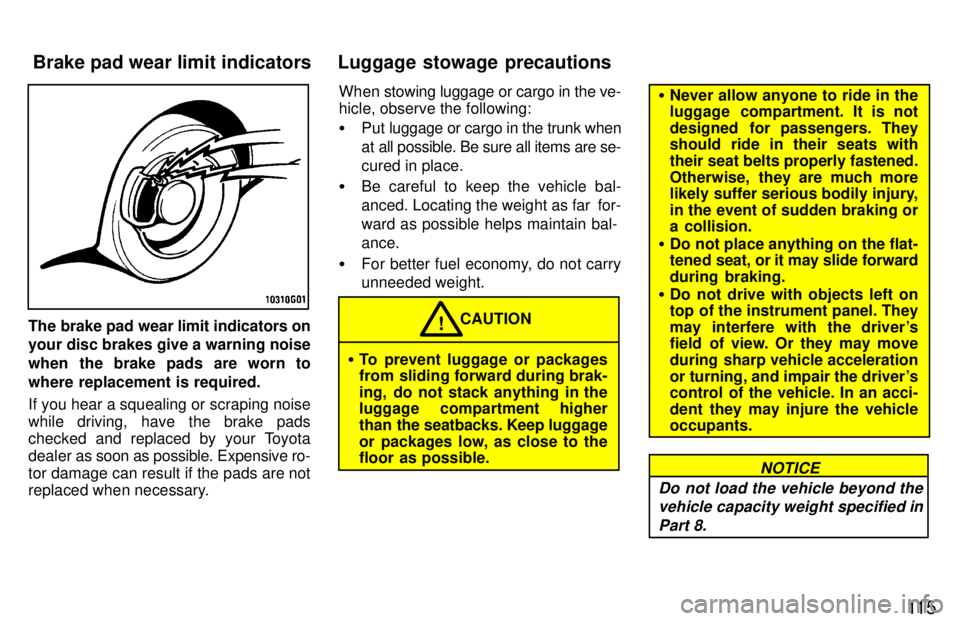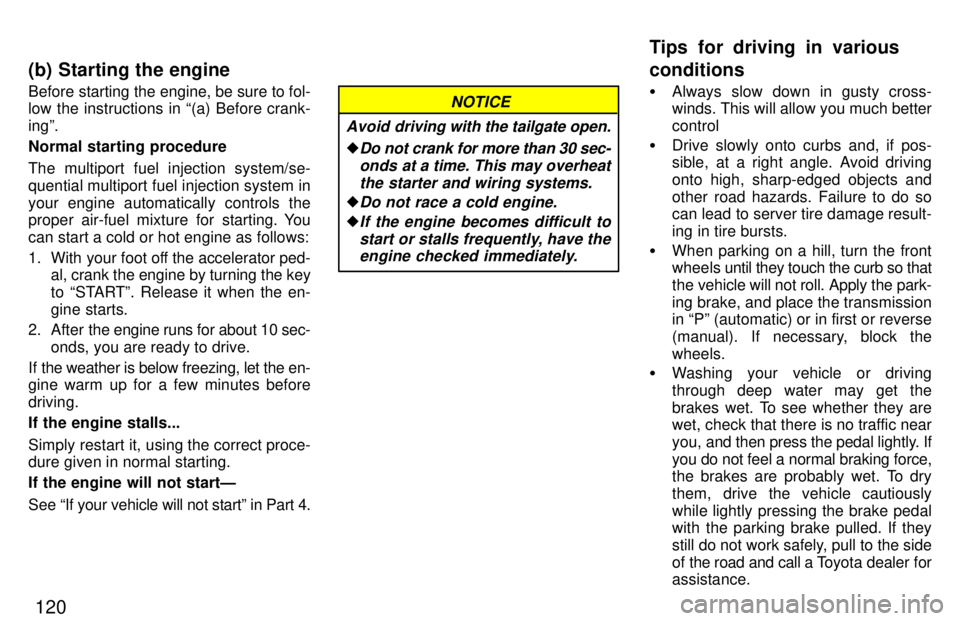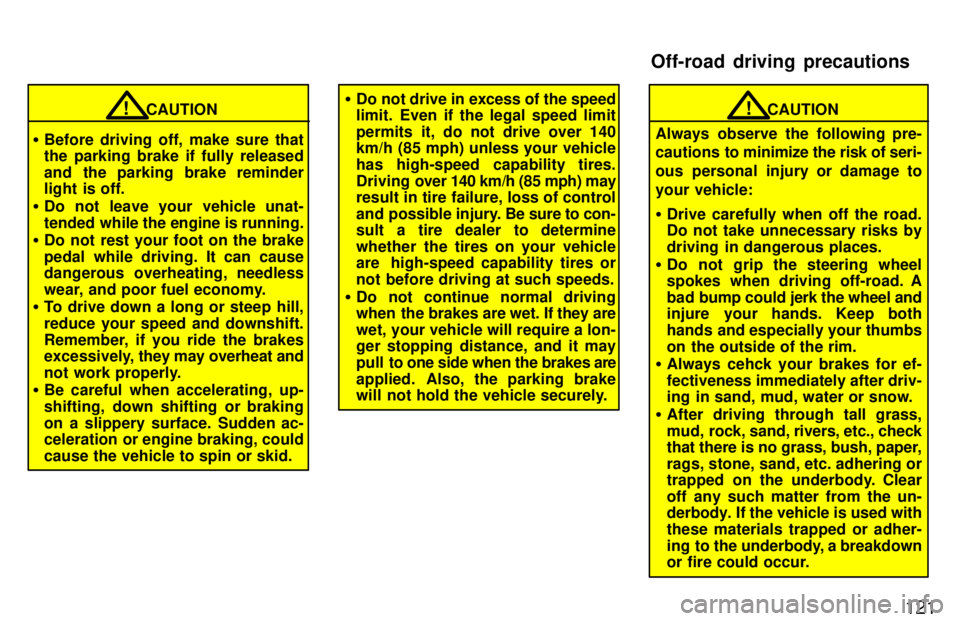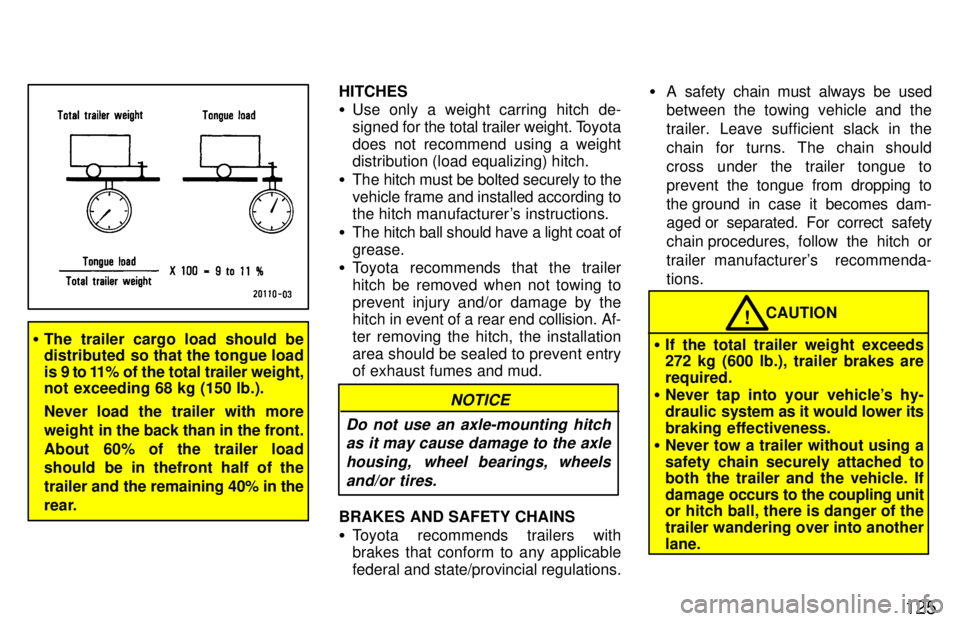1997 TOYOTA RAV4 brakes
[x] Cancel search: brakesPage 74 of 198

72
(a) Brake System Warning Light This light has the following functions: Parking brake reminder
If this light is on, make sure the parking
brake is fully released. The light should go
off.
Low brake fluid level warning
If this light comes on and stays on while
you are driving, slowdown and pull off the
road. Then stop the vehicle carefully.There maybe a problem somewhere in
the brake system. check the fluid level of
the see-through reservoir.
To make sure the parking brake has not
caused the warning light to come on,
check to see that the parking brake is fully
released.
If the brake fluid level is low...
At a safe place, test your brakes by start-
ing and stopping. � If you judge that the brakes still work
adequately, drive cautiously to yournearest dealer or shop for repairs.
� If the brakes are not working, have the
vehicle towed in for repairs. (For tow-
ing information, see Part 4.)
It is dangerous to continue driving
normally when the brake fluid level
is low. CAUTION
!
If the brake fluid level is correct...
Have the warning system checked by
your Toyota dealer. (b) Seat Belt Reminder Light and Buzzer
Once the ignition key is turned to ONº or
STARTº, the reminder light and buzzer
come on if the driver's seat belt is not fas-
tened. Unless the driver fastens the belt,
the light stays on and the buzzer stops af-
ter about 4 to 8 seconds.
(c) Discharge Warning Light
This light warns that the battery is being discharged.
If it comes on while you are driving, there
is a problem somewhere in the charging system.
The engine ignition will continue to oper-
ate, however, until the battery is dis-
charged. Turn off the air conditioning,
blower, ra dio, ect., and drive directly to the
nearest Toyota dealer or repair shop.
Page 114 of 198

11 3
TANDEM MASTER CYLINDER BRAKE SYSTEM
The tandem master cylinder brake sys-
tem is a hydraulic system with two sepa-
rate sub-systems. If either sub-system
should fa
il, the other will still work. Howev-
er, the pedal will be harder to press, and
your stopping distance will be longer.
Also, the brake system warning light may come on.
CAUTION!
Do not drive your vehicle with only a single brake system. Have your
brakes fixed immediately.
BRAKE BOOSTER
The brake booster uses engine vacuum to
power-assist the brakes. If the engine
should quit while you are driving, you can
bring the vehicle to a stop with normal
pedal pressure. There is enough reserve vacuum for one or two stopsÐbut nomore!
CAUTION!
� Do not pump the brake pedal if the
engine stalls. Each push on the
pedal uses up your vacuum re- serve.
� Even if the power assist is com-
pletely lost, the brakes will still
work. But you will have to push
the pedal hardÐmuch harder
than normal. And your braking
distance will be longer.
ANTI-LOCK BRAKE SYSTEM (with ABSº warning light)
The anti-lock brake system is designed to
automatically help prevent lock-up of the
wheels during sudden braking or braking on slippery road surfaces. This assists in
providing directional stability and steeringperformance of the vehicle under these circumstances.
The anti-lock brake system becomes op- erative after the vehicle has accelerated
to a speed in excess of approximately 10
km/h (6 mph). It stops operating when the
vehicle decelerates to a speed below
approximately 5 km/h (3 mph). You may hear a sound in the engine
compartment for a
few seconds when the
engine is started or just after the vehicle is started. This means that the anti-lock
brake system is in the self check mode,
and does not indicate a malfunction.
Effective way to press the ABSº brake
pedal: When the anti-lock brake system
function is in action, you may feel the brake pedal pulsating and hear a noise.
In this situation, to let the anti-lock brake
system work for you, just hold the brake
pedal down more firmly. Do not pumpthe brake. This will result in reduced
braking performance.
The brake pedal pulsation caused by the
anti-lock brake system may indicate haz- ardous road surface conditions. Althoughthe anti-lock brake system assists in pro-
viding vehicle control, it is still important to
drive with all due care, because the anti-
lock brake system cannot overcome the
laws of physics that act on your vehicle: � Braking capab ility is dependent on tire
friction with the road surface.
Brake system
Page 116 of 198

11 5
The brake pad wear limit indicators on your disc brakes give a warning noise
when the brake pads are worn to
where replacement is required.
If you hear a squealing or scraping noise
while driving, have the brake pads
checked and replaced by your Toyota
dealer as soon as possible. Expensive ro-
tor damage can result if the pads are not
replaced when necessary. When stowing luggage or cargo in the ve-
hicle, observe the following: �
Put luggage or cargo in the trunk when
at all possible. Be sure all items are se-cured in place.
� Be careful to keep the vehicle bal-
anced. Locating the weight as far for-
ward as possible helps maintain bal-ance.
� For better fuel economy, do not carry unneeded weight.CAUTION!
� To prevent luggage or packages
from sliding forward during brak-
ing, do not stack anything in the
luggage compartment higher
than the seatbacks. Keep luggage
or packages low, as close to the
floor as possible.
� Never allow anyone to ride in the
luggage compartment. It is not
designed for passengers. They
should ride in their seats with
their seat belts properly fastened.
Otherwise, they are much more
likely suffer serious bodily injury, in the event of sudden braking or a collision.
� Do not place anything on the flat-
tened seat, or it may slide forward
during braking.
� Do not drive with objects left on
top of the instrument panel. They
may interfere with the driver's
field of view. Or they may move
during sharp vehicle acceleration
or turning, and impair the driver's
control of the vehicle. In an acci-
dent they may injure the vehicle occupants.
Do not load the vehicle beyond the
vehicle capacity weight specified in
Part 8.
NOTICE
Brake pad wear limit indicators Luggage stowage precautions
Page 121 of 198

120
Before starting the engine, be sure to fol-
low the instructions in (a) Before crank- ingº.
Normal starting procedure
The multiport fuel injection system/se-
quential multiport fuel injection system in
your engine automatically controls the
proper air-fuel mixture for starting. You can start a cold or hot engine as follows:
1. With your foot off the accelerator ped-
al, crank the engine by turning the key
to STARTº. Release it when the en-
gine starts.
2. After the engine runs for about 10 sec-
onds, you are ready to drive.
If the weather is below freezing, let the en-
gine warm up for a few minutes before driving.
If the engine stalls...
Simply restart it, using the correct proce- dure given in normal starting. If the engine will not startÐ
See If your vehicle will not startº in Part 4.
NOTICE
Avoid driving with the tailgate open.
�Do not crank for more than 30 sec-
onds at a time. This may overheatthe starter and wiring systems.
�Do not race a cold engine.
�If the engine becomes difficult to
start or stalls frequently, have theengine checked immediately.
� Always slow down in gusty cross- winds. This will allow you much better control
� Drive slowly onto curbs and, if pos-
sible, at a right angle. Avoid driving onto high, sharp-edged objects and
other road hazards. Failure to do so
can lead to server tire damage result- ing in tire bursts.
� When parking on a hill, turn the front
wheels until they touch the curb so that
the vehicle will not roll. Apply the park-
ing brake, and place the transmission in Pº (automatic) or in first or reverse
(manual). If necessary, block thewheels.
� Washing your vehicle or driving
through deep water may get the
brakes wet. To see whether they are
wet, check that there is no traffic near
you, and then press the pedal lightly. If
you do not feel a normal braking force,
the brakes are probably wet. To dry
them, drive the vehicle cautiously
while lightly pressing the brake pedal
with the parking brake pulled. If they
still do not work safely, pull to the side
of the road and call a T oyota dealer for
assistance.
(b) Starting the engine
Tips for driving in various conditions
Page 122 of 198

121
CAUTION!
� Before driving off, make sure that the parking brake if fully released
and the parking brake reminder
light is off.
� Do not leave your vehicle unat-
tended while the engine is running.
� Do not rest your foot on the brake
pedal while driving. It can cause
dangerous overheating, needless
wear, and poor fuel economy.
� To drive down a long or steep hill,reduce your speed and downshift.
Remember, if you ride the brakes
excessively, they may overheat and
not work properly.
� Be careful when accelerating, up-
shifting, down shifting or braking
on a slippery surface. Sudden ac-
celeration or engine braking, could cause the vehicle to spin or skid.�Do not drive in excess of the speed
limit. Even if the legal speed limit
permits it, do not drive over 140
km/h (85 mph) unless your vehicle
has high-speed capability tires.
Driving over 140 km/h (85 mph) may
result in tire failure, loss of control
and possible injury. Be sure to con-
sult a tire dealer to determine
whether the tires on your vehicle
are high-speed capability tires or
not before driving at such speeds.
� Do not continue normal driving
when the brakes are wet. If they are
wet, your vehicle will require a lon-ger stopping distance, and it may
pull to one side when the brakes are
applied. Also, the parking brake
will not hold the vehicle securely.CAUTION!
Always observe the following pre-
cautions to minimize the risk of seri-
ous personal injury or damage to
your vehicle: � Drive carefully when off the road. Do not take unnecessary risks by
driving in dangerous places.
� Do not grip the steering wheel
spokes when driving off-road. A
bad bump could jerk the wheel and
injure your hands. Keep both
hands and especially your thumbs
on the outside of the rim.
� Always cehck your brakes for ef-fectiveness immediately after driv-
ing in sand, mud, water or snow.
� After driving through tall grass,
mud, rock, sand, rivers, etc., check
that there is no grass, bush, paper,
rags, stone, sand, etc. adhering or
trapped on the underbody. Clear
off any such matter from the un-
derbody. If the vehicle is used with these materials trapped or adher-
ing to the underbody, a breakdown
or fire could occur.
Off-road driving precautions
Page 123 of 198

122
�The driver and all passengers
should fasten their seat belts when-
ever the vehicle is moving.
NOTICE
�If driving through water, such as
when crossing shallow streams,
first check the depth of the water
and the bottom of the river bed forfirmness. Drive slowly and avoid
deep water.
�Take all necessary safety measuresto ensure that water damage to the
engine or other components does
not occur.Water entering the engine air in-
take will cause severe engine dam-age.Water can wash the grease from
wheel bearings, causing rusting and premature failure, and mayalso enter the differentials, trans-
mission and transfer case, reduc-ing the gear oil's lubricating quali-ties.
�Sand and mud that has accumu-lated in brake drums and around
brake discs may affect braking ef-
ficiency and may damage brakesystem components.
�Always perform a maintenance in-
spection after each day of off- road driving that has taken you
through rough terrain, sand, mud,
or water. For scheduled mainte-nance information, refer to the
separate Owner's Manual Sup- plement/Maintenance Scheduleº.
Make sure you have ethylene-glycol
antifreeze in the radiator.
Do not use alcohol type antifreeze.
NOTICE
Check the condition of the battery and cables. Cold temperatures reduce the capacity of
any battery, so it must be in top shape to provide enough power for winter starting. Chapter 7-3 tells you how to visually in-
spect the battery. Your Toyota dealer and
most service stations will be pleased to check the level of charge.
Make sure the engine oil viscosity is
suitable for the cold weather.
See Chapter 7-2 for recommended vis-
cosity. Leaving a heavy summer oil in your
vehicle during winter months may cause
harder starting. If you are not sure about
which oil to use, call your Toyota dealer- he will be pleased to help. Keep the door locks from freezing. Squirt lock de-icer or glycerine into the
locks to keep them from freezing. To open
a frozen lock, try heating the key before in-serting it.
Winter driving tips
Page 126 of 198

125
�The trailer cargo load should be
distributed so that the tongue load
is 9 to 11% of the total trailer weight,
not exceeding 68 kg (150 lb.).
Never load the trailer with more
weight in the back than in the front.
About 60% of the trailer load
should be in thefront half of the
trailer and the remaining 40% in the
rear. HITCHES �
Use only a weight carring hitch de-
signed for the total trailer weight. T oyota
does not recommend using a weight
distribution (load equalizing) hitch.
� The hitch must be bolted securely to the vehicle frame and installed according to
the hitch manufacturer's instructions.
� The hitch ball should have a light coat of grease.
� Toyota recommends that the trailer
hitch be removed when not towing toprevent injury and/or damage by the
hitch in event of a rear end collision. Af-
ter removing the hitch, the installation
area should be sealed to prevent entry of exhaust fumes and mud.
NOTICE
Do not use an axle-mounting hitch as it may cause damage to the axle
housing, wheel bearings, wheels and/or tires.
BRAKES AND SAFETY CHAINS � Toyota recommends trailers with brakes that conform to any applicable
federal and state/provincial regulations. �
A safety chain must always be used
between the towing vehicle and the
trailer. Leave sufficient slack in the
chain for turns. The chain should
cross under the trailer tongue toprevent the tongue from dropping to
the ground in case it becomes dam-
aged or separated. For correct safety
chain procedures, follow the hitch or
trailer manufacturer's recommenda-tions.
CAUTION!
� If the total trailer weight exceeds
272 kg (600 lb.), trailer brakes are required.
� Never tap into your vehicle's hy-
draulic system as it would lower its
braking effectiveness.
� Never tow a trailer without using a
safety chain securely attached to
both the trailer and the vehicle. If
damage occurs to the coupling unit
or hitch ball, there is danger of the
trailer wandering over into anotherlane.
Page 128 of 198

127
�
Avoid jerky starts or sudden accelera- tion. If your vehicle has manual trans-
mission, prevent excessive clutch slip-
page by keeping engine rpm low and
not racing the engine. Always start out
in first gear.
� Avoid jerky steering and sharp turns.
The trailer could hit your vehicle in a
tight turn. Slow down before making a
turn to avoid the necessity of sudden braking.
� Backing w ith a trailer is difficult and re-
quires practice. Grip the bottom of thesteering wheel and move your hand to
the left to move the trailer to the left. Move your hand to the right to move
the trailer to the right. (This procedure is generally opposite to that when
backing without a trailer). Also, just
turn the steering wheel a little at a time,
avoiding sharp or prolonged turning. Have someone guide you when back-
ing to reduce the risk of an accident.
� Remember that when making a turn, the trailer wheels will be closer than the vehicle wheels to the inside of the
turn. Therefore, compensate for this
by making a larger than normal turning
radius with your vehicle. �
Crosswinds and rough roads will ad-
versely affect handling of your vehicle
and trailer, causing sway. Pay atten-
tion to the rear from time to time to pre-
pare yourself for being passed by largetrucks or buses, which may cause your
vehicle and trailer to sway. If swaying
happens, firmly grip the steering wheel
and reduce speed immediately but
gradually. Never increase speed.
Steer straight ahead. If you make no
extreme correction with the steering or
brakes, the vehicle and trailer will sta- bilize.
� Be careful when passing other ve- hicles. Passing requires considerable
distance. After passing a vehicle, do
not forget the length of your trailer and
be sure you have plenty of room be-
fore changing lanes.
� In order to maintain engine braking ef-
ficiency, do not use fifth gear (manual
transmission or overdrive (automatic transmission).
� Because of the added load of the trail-
er, your vehicle's engine may overheat
on hot days (at temperatures over30 5C [85 5F]) when going up a long or steep
grade with a trailer. If the engine
coolant termperatue gauge indicates
overheating, immediately turn off the
air conditioning (if in use), pull off the
road and stop in a safe spot. Refer to
If your vehicle overheatsº in Part 4 ofthis manual.
� Always place wheel blocks under both
the vehicle and trailer wheels whenparking. Apply the parking brake firm-
ly. Put the transmission in Pº (auto-
matic) or in first or reverse (manual).
Avoid parking on a slope with a trailer, but if it cannot be avoided, do so onlyafter performing the following:
1. Apply the brakes and hold.
2. Have someone place wheel blocks un-
der both the vehicle and trailer wheels.
3. When the wheel blocks are in place, release your brakes slowly until the blocks absorb the load.
4. Apply the parking brake frimly.
5. Shift into first or reverse (manual) or Pº (automatic) and turn off the engine.